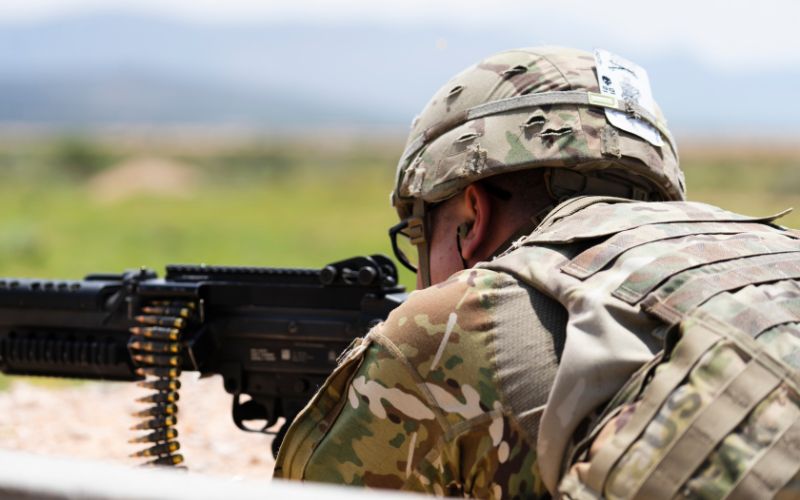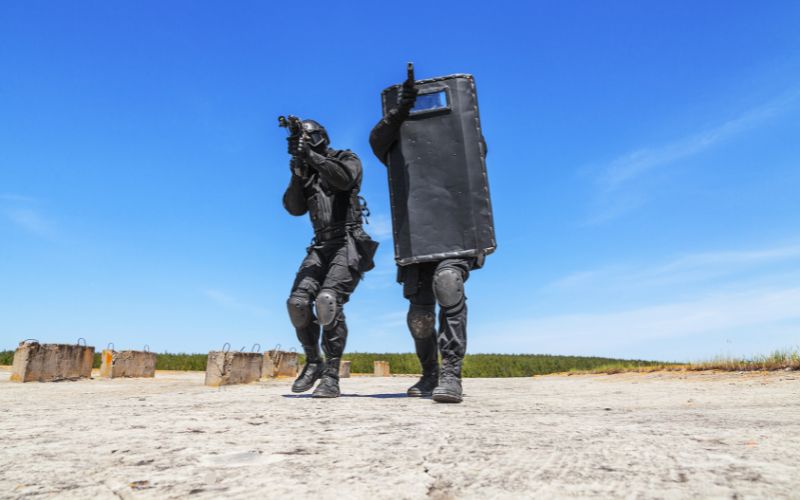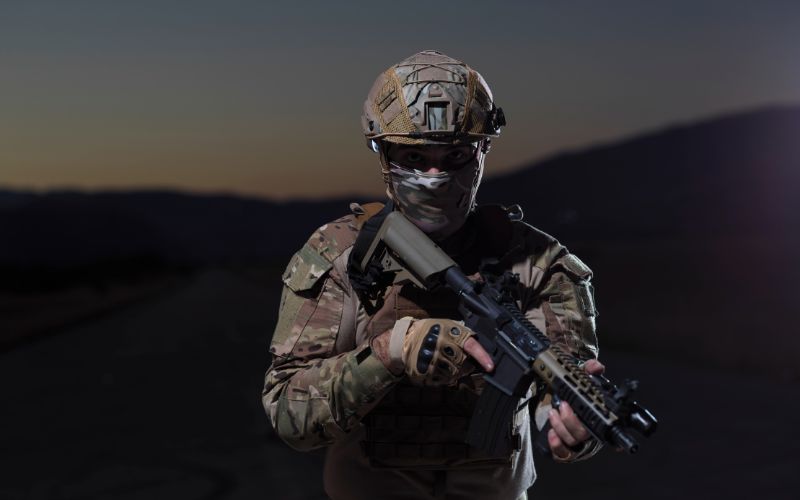The Role Of Ballistic Shields In SWAT And Tactical Operations

In law enforcement, tactical operations require specialized equipment designed to protect officers and neutralize threats. Ballistic shields are among the most essential tools in a SWAT officer’s arsenal. These devices play a critical role in ensuring the safety of law enforcement personnel during high-risk situations such as hostage rescues, active shooter scenarios, and armed confrontations. This blog establishes the role of ballistic shields in SWAT and tactical operations and their function in delineating their role, design, functionality, and how they can enhance operational success and officer safety.
What Is A Ballistic Shield?
A ballistic shield is a portable shield that can stop bullets and other projectile attacks. Typically, the ballistic shields are made up of advanced materials such as Kevlar, polyethylene, and other composite materials that can absorb and distribute the impact force of the bullet. They also come in many sizes, shapes, and configurations to suit the operation and protection needed.
Ballistic shields are mainly employed by SWAT teams, tactical units, and other law enforcement agencies when conducting high-risk operations. They provide an officer with a safe barrier against potential threats, allowing the officer to move and engage suspects with greater protection. A ballistic shield can distinguish between life and death in a dangerous situation.
Importance Of Ballistic Shields In Tactical Operations
Ballistic shields are important equipment that increases safety and efficiency in tactical operations. They help officers approach dangerous situations with reduced exposure to gunfire and other threats. The importance of such equipment cannot be overstated, especially in risky environments, since they offer protection and facilitate greater maneuverability.
1. Ballistic Shield Against Firearms
The most common threat officers face in tactical operations is gunfire. Whether they are rescuing hostages, negotiating a standoff with armed suspects, or preparing for an active shooter scenario, officers must be prepared to protect themselves from hostile gunfire. Ballistic shields, depending on the level of ballistic protection, provide an effective defense against various types of ammunition, including handgun rounds, shotgun pellets, and even certain types of rifle rounds.
These shields allow officers to traverse hostile environments without exposure to direct gunfire. They have the advantage of covering while remaining positioned to neutralize threats. The ability to advance on a suspect or approach a dangerous situation with protection greatly enhances the likelihood of a successful resolution.
2. Increased Mobility and Flexibility

The main benefit of ballistic shields is that they provide officers with mobility. In the past, law enforcement officers could only advance on suspects using stationary cover or minimal protection. Modern ballistic shields allow officers to move around while providing high protection.
Ballistic shields are available in various sizes, so a SWAT team can select the one best suited to its mission. Small shields enable officers to navigate effectively in smaller spaces, such as doorways, hallways, or stairwells, whereas more massive shields provide additional protection in more open areas. These shields are lightweight enough to enable a tactical team to move quickly while advancing, retreating, or repositioning in a time-sensitive situation.
3. Protection of Several Officers
Several officers working in tandem often use ballistic shields. This collaborative use protects the entire team while moving in one direction toward the suspect or securing a dangerous place. The shields produce a nearly impenetrable barrier that protects officers from shots and debris.
Many SWAT officers will position themselves in a protective “wall” with their ballistic shields to move in tandem. This technique is very useful in hostage rescue operations or if entering a building with an unknown threat. In doing so, each officer is shielded from potential gunfire, thus lessening the potential for team casualties.
4. Psychological Advantage

While ballistic shields provide a physical advantage, they also present a psychological benefit in high-risk situations. Seeing officers advance with the right ballistic shields can disorient suspects and may make them reassess their intentions. The shield is a deterrent, signifying the suspect that the officers are ready and well-prepared for the confrontation.
In addition, shields can help de-escalate situations. Sometimes, suspects surrender when they recognize that law enforcement is better equipped and has an overwhelming advantage, especially with tactical gear such as ballistic shields. This psychological benefit may result in a peaceful outcome without the necessity of deadly force.
5. Increased Protection for Close Quarters Combat
Tactical operations are often executed in close-quarters combat (CQC), where police officers may face suspects at point-blank distances in cramped places. In those situations, ballistic shields come in handy, protecting officers against sudden gunfire, stabbings, and other attacks at close range. The shields protect against bullet penetration and can deflect or neutralize various physical attacks involving knives or weapons that may have been used from proximity.
The right ballistic shields are designed to be compact and thus perfectly suited for close-quarter combat operations. They will protect the user and allow one to engage a suspect effectively. For instance, SWAT officers will use the shields to enter buildings, clean rooms, and catch suspects in tight spaces without compromising their safety.
6. Versatility in Various Tactical Scenarios
Ballistic shields are versatile in tactical situations, such as hostage, crowd control, or counterterrorism operations. Their design and materials can easily adapt to any environment or threat.
Taking a hostage helps the officers present protection during negotiations or when approaching a suspect. Officers will be protected from thrown objects and other projectiles during crowd control. In counter-terrorism operations, officers use ballistic shields to handle people carrying weapons when entering buildings.
Some Main characteristics Of Ballistic Shields
To ensure maximum protection and functionality, modern ballistic shields are equipped with several key features that enhance their effectiveness in the field:
1. Level of Protection
Ballistic shields are rated based on how much ammunition they can absorb from various firearms. Some standard protection levels are Level IIIA, which is good against handgun and shotgun rounds, and Level III, which is good for stopping rifle rounds. Tactical teams can choose a shield based on the threat level they might encounter in a given situation.
2. Clear Viewing Windows
Many ballistic shields have a transparent, bullet-resistant window. This allows the officer to be aware of his surroundings while staying protected. It is crucial in making tactical decisions or identifying threats when the clear window allows him to see around.
3. Ergonomic Handles and Straps
Most designs have ergonomic handles or straps to make the shield more comfortable and maneuverable. This allows officers to hold and position the shield without discomfort. Adjustable straps also provide a snug fit, which minimizes fatigue and ensures that the shield is available when officers need it most.
4. Weight and Portability
Although modern ballistic shields are designed to be lightweight and portable, they can still provide protection. The materials are strong but not too heavy, so officers can carry and deploy the shield without compromising mobility. This balance of protection and portability is crucial in high-pressure tactical situations.
Conclusion
Ballistic shields are necessary for SWAT teams and tactical officers because they protect personnel in hostile, unpredictable environments. They are valuable because they protect officers against gunfire, enhance mobility, and provide psychological advantages. In addition to their physical benefits, the shield allows officers to approach risky situations more confidently and precisely. As tactical operations evolve, ballistic shields will remain crucial in ensuring officers’ safety and achieving the mission’s success.
Frequently Asked Questions
What are ballistic shields made of?
Ballistic shields are usually made of advanced materials, such as Kevlar, polyethylene, and other composite fibers. These materials absorb and dissipate bullet energy, providing the best protection for officers.
Do ballistic shields stop rifle rounds?
Yes, some of them are even designed to stop rifle rounds. Shields rated Level III or above can protect against rifle ammunition. They are well suited for operations involving armed suspects.
How heavy are ballistic shields?
A ballistic shield will weigh depending on its size and level of protection. Modern designs are light enough for officers to carry and deploy with minimal loss of mobility.

